

| Glow Worms - a detailed summary 2017 |
| 2017 Glow Worm sightings |
| Clipstone Old Quarter female Glow Worm data 2017 |
| .. |
| This was a most unusual
glowing season, perhaps our most unusual ever at
Clipstone Old Quarter in Sherwood Forest. It produced an early start, at one time the prospect of an almost incredibly early end, Glow Worms in a survey section we thought would produce very little, seemingly unusually large numbers of males and a possible (but not surprising) link between temperature and predicting when the first Glow Worms may appear in Spring. The 2017 season in brief Overall, the season lasted from recording our third earliest ever female Glow Worm on May 20th, before finally ending on July 27th and producing a total of 273 females from six survey sections. |
|
|||
| .. | ||||
| Spring
2017 larval survey results and data Our late afternoon and early evening larval surveys of sections A, B, C and D commenced on March 9th, with the first two larvae being recorded a few days later on March 14th. If you are new to reading our summaries, these four sections form a long grass strip, bordered on one side by a cycle path, on which wandering, pre-pupating larvae can be found during the early Spring months. By April 8th, a pleasing total of 38 larvae had been recorded, measured and released, so we were quite hopeful for a good season. There was a change to much cooler weather during the second half of April, meaning we didn't conduct regular larval surveys for the rest of April or May, so the larval data produced this year is limited and not really of very much use. |
||
| .. |
| Fig 01. ... Diurnal Glow Worm larval size ranges found during March 2017 | ||||||||||||||||||||||||
| .. | ||||||||||||||||||||||||
| 9mm-15mm larval size range | Intermediate | 19mm-28mm larval size range | ||||||||||||||||||||||
| Section | .. | 9mm | 10mm | 11mm | 12mm | 13mm | 14mm | 15mm | .. | 16mm | 17mm | 18mm | .. | 19mm | 20mm | 21mm | 22mm | 23mm | 24mm | 25mm | 26mm | 27mm | 28mm | |
| A | .. | .. | .. | .. | .. | .. | .. | .. | .. | .. | .. | .. | .. | .. | .. | .. | .. | 1 | .. | .. | .. | .. | .. | |
| B | .. | .. | .. | .. | .. | 1 | .. | .. | .. | .. | 3 | 1 | .. | 1 | 2 | .. | .. | .. | .. | .. | .. | .. | .. | |
| C | .. | .. | .. | .. | .. | .. | 1 | .. | .. | .. | 2 | 2 | .. | 1 | .. | .. | .. | .. | .. | 1 | .. | .. | .. | |
| D | .. | .. | .. | .. | .. | .. | .. | 1 | .. | 1 | 2 | .. | .. | .. | .. | .. | .. | .. | .. | .. | 1 | .. | .. | |
| .. | ||||||||||||||||||||||||
| 9mm-15mm larval size range 14.00% | Intermediate 52.00% | 19mm-28mm larval size range 34.00% | ||||||||||||||||||||||
| Total % | .. | 0.00 | 0.00 | 0.00 | 0.00 | 4.00 | 4.00 | 4.00 | .. | 4.00 | 33.00 | 14.00 | .. | 10.00 | 10.00 | 0.00 | 0.00 | 4.00 | 0.00 | 4.00 | 4.00 | 0.00 | 0.00 | |
| Although April turned decidedly cooler, there were actually few nights with a ground or air frost. The cool nights and lack of any real warm Sun during daylight hours, meant that the prospect for any early females began to seem unlikely. A lack of rain didn't help the situation and some larvae found during the surveys did appear to be quite thin. Best of the larval counts were six on March 19th, eight on April 1st and five on April 8th. | ||
| ...... |
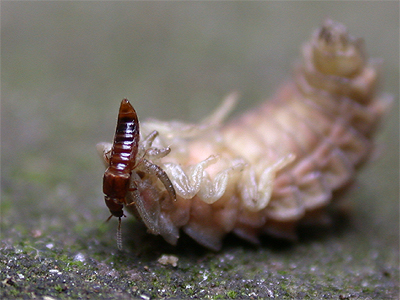 |
In May, we started our
late evening (nocturnal) surveys for female Glow Worms.
While on the look out for females at this early stage of
the season, we sometimes find pre-pupating larvae,
producing long duration glows. These glows can last
several minutes on occasion, but are normally around 30
seconds long. As the season continues into July and August, hunting larvae producing short duration glows are found with increasing regularity. 2017 proved to be exceptionally poor for finding larvae after dark and we recorded glowing larvae on just two occasions between May 18th and July 31st. On the other hand, we fared quite well in finding glows which (on closer inspection) turned out to be from newly formed pupae. We have found pupae on a number of occasions over the years, always found glowing after dark, when they are either freshly formed, or when they have been disturbed by a potential predator. |
| ...... | ||
| On May 24th,
a glowing female pupa was found in Section O and appeared
to have been freshly predated, possibly by a quite large
parasitic wasp found in attendance, but which evaded
capture. We had hoped to find the small Staphylinid Alaobia scapularis (Sahlberg, 1831) which is well known for its association with Glow Worm larvae. The only previous Nottinghamshire record for A. scapularis we know of, is of two we found with a female Glow Worm pupa at Clipstone Old Quarter on May 30th 2013. So we were delighted on the following evening, when we were fortunate enough to find another female pupa glowing along Section M and that two Alaobia scapularis were in attendance. Both evaded capture, so the pupa was located to a safer site underneath a stone and left, hoping they (or others) would return. We continued to check the pupa on subsequent nights, in an attempt to secure a specimen for photographing and after missing a third A. scapularis on May 27th, we were eventually successful two evenings later. |
||
| ...... |
| A possible link between the average
Winter/Spring temperature and the first Glow Worm Seasonal variations have tended to produce very mild Winters in recent years, often with a short spell of snow or icy conditions. The past couple of Winters have barely produced a frost here, let alone any snow and we once again experienced yet another very mild Winter, which developed into a cool and dry Spring - almost a carbon copy of early 2016. With a number of Glow Worm larvae appearing relatively early this March, it began to look promising for a potentially early start to this year's glowing season. |
|||||||||||||||||||||||||||||||||||||||||||||||||||||||||||||||||||||||||||||||||||||||||||||||||||||||||||||||||||||||||||||||||||||||||||||||||||||||||||||||||||||||
| ...... | |||||||||||||||||||||||||||||||||||||||||||||||||||||||||||||||||||||||||||||||||||||||||||||||||||||||||||||||||||||||||||||||||||||||||||||||||||||||||||||||||||||||
|
But with a change in the
weather during April, most nights became much cooler,
with the overnight temperature often dropping well into
single figures. Before Spring 2017, a look at the average monthly minimum and maximum temperatures for the years 2008-2016 in Fig 02, showed that previous early glowing seasons followed when the average minimum temperature for the period January to April was 3.5°C or above. This also applied when the average maximum temperature was above 10.5°C for the period January to April for the same two years. |
||||||||||||||||||||||||||||||||||||||||||||||||||||||||||||||||||||||||||||||||||||||||||||||||||||||||||||||||||||||||||||||||||||||||||||||||||||||||||||||||||||||
| ...... |
| When the
average temperatures for April were released, the average
minimum temperature for the area from January to April
2017 was found to be 3.5°C and the average maximum was
found to be just over 10.0°C. On May 17th 2017, we
published our predictions that this season could be
another early one, and we were pleased to have been
proved right for once. The first female was found glowing
three days later on May 20th. The 2017 Glow Worm season in more detail We were again unable to survey the whole site each night and restricted ourselves to surveying sections (in order of completion) O, L, M, K, J and D. Our former survey route was well over 6km long, had 18 sections (A to S) and took us around two hours to complete most nights. It became impractical for us to do anymore and this year, we had to omit sections of A, B and C, which are pretty much un-surveyable now through large areas of encroaching Bracken and Bramble. |
| ...... | ||
| Towards the end of our
2016 Glow Worm summary, we looked at how Pine harvesting
by the Forestry Commission had affected the Glow Worm
population along Section S, by virtually wiping out
recorded larvae found there in 2013. Only six female Glow
Worms managed to make it to maturity the following year,
when the number of female larvae was known to have been
much higher before the harvesting took place. The felling of Clipstone Old Quarter's last two large areas of Pine began in late August 2016 and by mid-September, there were huge timber stacks lining the track sides, which were held off the ground by timber supports. We knew that there would be damaging implications to both Glow Worm habitat and Glow Worm larvae along Sections O, L, K and J, and we were at least able to monitor the immediate effects of what turned out to be a combination of Pine felling, timber extraction, timber stacking, forest track widening and spoil spreading. |
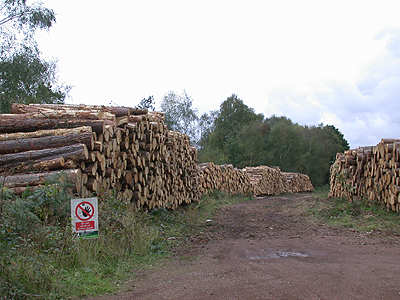 |
|
| ...... | ||
| Bracken
control (usually done with Asulox) and more general
herbicidal applications within some areas, added further
pressure on the invertebrate fauna in general and some
felled areas showed signs of Glyphosate use. Many of our
former survey sections not surveyed this year, were also
affected by the work. Although we surveyed Sections L and M each night in 2017, the data from these sections is not included in the analysis that follows later. This is due to the lack of coverage in 2015 and not surveying either Section L or M in 2016. Despite the gap in coverage, having data from these sections between 2010 and 2014 and knowing the Glow Worm population from both sections, does mean that we have the knowledge to come to certain conclusions. We can say without doubt, that the Glow Worm population along Section L was severely affected by felling, timber extraction and stacking in 2016 and 2017. The work effectively removed all larvae and all but a single female Glow Worm from almost the whole length of Section L, but certainly from where Pines were removed and the ground was prepared for timber to be stacked prior to removal. The timber stacks had been removed some weeks prior to surveying and in the above photograph, Glow Worms were only recorded from a point past the furthest end of the timber stack on the left hand side. Several females were found this end of both stacks and from behind where the photograph was taken, but these were actually just in the adjoining sections of O and K. |
| ...... | ||
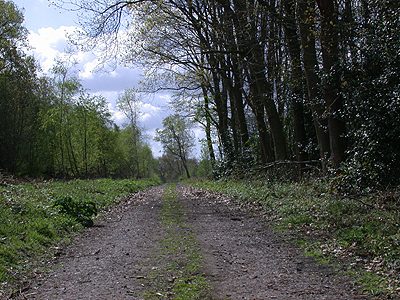 |
Forestry operations
transformed the appearance and 'feel' of Sections J and
K, by completely opening both sections up to a much
greater amount of sunlight and prevailing westerly winds.
Additional spoil as a by-product of track widening, meant
the loss of some larvae (and consequently some adults)
from both sections. Interestingly, most female Glow Worms were recorded glowing from the western-side of the track running through Sections K and J, which we think may be due to female larvae selecting the most open aspect from which to glow from as adult. Females obviously favouring one side of a track, is not something we have noticed before. Section K was the location for the first female Glow Worm (F001) of the 2017 season on May 20th, being found nine evenings after we began surveying for adults on May 11th and three days after predicting that the season could be an early one. |
|
| ...... | ||
| F001 was
missing the following evening, but reappeared again on
May 23rd, along with a second female (F002) in Section L
and a surprising third female (F003) in Section O. We'd expected the Glow Worm population in Section O (above) to be decimated through track widening and the creation of a new turning point for lorries removing the timber near to Peafield Lane. Most of the Birch and other young trees had been removed down the whole length of one side of the track in Section O, and there were large amounts of spoil that had been spread. We thought that the one area of deciduous trees bordering this section, would offer us our best chance of recording Glow Worms along this section in 2017, as this was virtually unaffected by the forestry operations. But we were surprised at how some Glow Worms had survived the felling and extraction in other parts (good numbers in one small area), while we recorded just one female from what we thought was likely to be safest. Section O has often been one of the later sections to become active at Clipstone Old Quarter, with females appearing a good two weeks later than the traditionally early south-facing sections. Female F003 was certainly a surprise to us on May 23rd and like most females found along all the forest tracks this year, was found well away from the path edges and just about on the limit of spoil spread from track widening. |
| ...... | ||
| Fig 03. ... Male and female Glow Worm counts during 2017 | ||
 |
||
| ...... |
| Activity from
Sections O, K and J ended very early and the lack of
freshly emerging females became evident in all sections
apart from Section D. Few new females appeared after
mid-June, by which time we had expected an early finish
to the season. In fact, the season had appeared to end as
early as July 8th (at least two to three weeks earlier
than expected) but after a run of five consecutive blank
nights, two females promptly appeared in Section D on
July 14th, before the last female of the season (F273)
appeared on July 15th. Only F272 remained after July 16th
and she continued to glow on and off for 14 evenings,
until failing to appear on July 27th. In the end, the
glowing season almost reached August. An unusual feature of the season, was that only a handful of females were present for longer than a week. These either remained unmated, as in the case of females F009, F261 and F272, or started glowing for a second time (F078, F093 and F230) following a prolonged period of absence. F093 was interesting, as she reappeared for her second night on June 16th, eleven nights after first glowing on June 5th. |
| ... | ||
| Fig 04. ... Average Glow Worm totals between 2010 and 2017 | ||
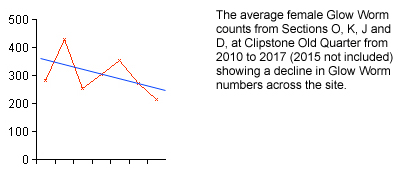 |
Section D was unaffected
by the forestry work, but is becoming less suitable for
Glow Worms and is now in need of some light management.
This year, it seemed increasingly evident that females
were becoming more confined to the centre of the grass
strip in Section D, as scrub and invasive weeds encroach
from both sides. Vegetative encroachment has assisted the decrease in the number of females being found along the path edges in this section. We had noted the decline in previous years, so larvae searching for a suitably open pupation site, now have to wander even further away from tall vegetation than they did a few years ago. |
|
| ... | ||
| A general
decline in Glow Worm numbers is by no means restricted to
Section D, as sections O, K and J have also seen some
amount of decline over recent years. Sections K and J
have probably fared worst of the four survey sections, as
Sections O and D have seen numbers remain generally
stable (although seemingly declining at a slower rate)
and Section D still accounts for around 50% of the Glow
Worm population in any year. Sections K and J are similar by habitat and have tended to fare equally similarly most years. However, both sections occasionally show large changes in population counts some years. In 2012, both suffered large drops in the number of Glow Worms with produced counts dropping by 89% in Section K and 58% in Section J. We found that although the Glow Worm populations in sections O, K, J and D during 2017, were more or less in line with levels averaged over the past number of years, their numbers are still declining at Clipstone Old Quarter. |
||
| ... |
| Fig 05. ... Total number of females and corresponding total percentages for Sections D, J, K and O only | |||||||||||||||||||||
| .. | |||||||||||||||||||||
| 2010 | 2011 | 2012 | 2013 | 2014 | 2016 | 2017 | |||||||||||||||
| .. | .. | tGW = 282 | .. | tGW = 427 | .. | tGW = 252 | .. | tGW = 305 | .. | tGW = 352 | .. | tGW = 273 | .. | tGW = 213 | |||||||
| Section | .. | Total | % | .. | Total | % | .. | Total | % | .. | Total | % | .. | Total | % | .. | Total | % | .. | Total | % |
| D | .. | 095/282 | 33.68% | .. | 212/427 | 49.64% | .. | 157/252 | 62.30% | .. | 139/305 | 45.57% | .. | 149/352 | 42.32% | .. | 163/273 | 59.70% | .. | 105/213 | 49.29% |
| J | .. | 107/282 | 37.94% | .. | 110/427 | 25.76% | .. | 046/252 | 18.25% | .. | 103/305 | 33.77% | .. | 102/352 | 28.97% | .. | 067/273 | 24.54% | .. | 051/213 | 23.94% |
| K | .. | 035/282 | 12.41% | .. | 046/427 | 10.77% | .. | 005/252 | 01.98% | .. | 026/305 | 08.52% | .. | 038/352 | 010.79% | .. | 013/273 | 04.76% | .. | 015/213 | 07.04% |
| O | .. | 045/282 | 15.95% | .. | 059/427 | 13.81% | .. | 044/252 | 017.46% | .. | 037/305 | 012.13% | .. | 063/352 | 017.89% | .. | 030/273 | 010.98% | .. | 042/213 | 19.71% |
| .. | |||||||||||||||||||||
| The overall feeling we had regarding the number of Glow Worms while surveying this year, was that their numbers were considerably down on previous years. Looking through the results, we recorded Glow Worm counts into double figures on just 11 evenings out of a total of 59 when Glow Worms were recorded. So most counts were often only in single figures. | ||||||||||||
| ... | ||||||||||||
| The season's highest
counts turned out to be 34 females on June 5th and 48
females on June 7th. No other counts came near to those
and it was difficult to determine anything other than a
generally flat peak in Glow Worm activity this year.
There was certainly no obvious peak in activity, as was
recorded in 2013 and 2016 for example. In order for there to be any prolonged peak, there has to be a build up of un-mated females over successive nights, in addition to a supply of freshly emerged females. Therefore, the contributing factor towards the low numbers of females in 2017, was that the biggest percentage of them were being mated on the first night glowing. Following the change in survey route and survey sections/order, we often walked along Section O for a second time on return back to the car. This was usually much less than an hour after first starting our survey. In many cases, females recorded on the way up had already gone 'lights out' by the time we returned and if they were still lit, they had usually attracted males. The season soon became talked about for what seemed to be larger than average numbers of males being found by recorders. We often remarked on the number of males ourselves during our surveying, thinking at the time that it was an unusual. |
|
|||||||||||
| ... | ||||||||||||
|
The higher the percentage
of females glowing for only one evening, is a guide we
regularly use to determine when the number of males
reaches a peak during the season. Fig 07 on the left, shows the percentage of 'one night' females in 2017. The second column shows the inclusive dates of the numbered females and the total number of 'one night' females per 50 females involved is shown in column three. The resulting percentage of females mated on the first night is then given in column four. |
|||||||||||||||||||||||||||||||||
| ... | ||||||||||||||||||||||||||||||||||
| What we had
assumed were unusually high numbers of males, were not
only recorded from Clipstone Old Quarter, but also
reported from sites in elsewhere in the UK. On favourable
nights, artificial lures employed at some of these sites
attracted dozens of males in no time at all and Martin
Dale and ourselves had 30 males to lure at Clipstone Old
Quarter on May 31st. Peak numbers of males came during late May and June 10-25th and 86% of females mated on their first night is indeed a high total, but not the highest we have recorded here (92% in 2011) and only just above a similar 84% in 2010. In terms of actual numbers of males with females, we recorded 71 males with females in 2017, compared to 38 males with females in 2016 and some 90 males with females in 2014. The highest numbers of male Glow Worms recorded with females came in 2010 and 2011. |
||
| ... |
|
Fig 08 shows the maximum
recorded percentages of 'one night' females at Clipstone
Old Quarter between 2010 and 2017. The total number of
males (nM) recorded during each season is given in column
two, with column three showing the date range per 50
females involved and column four giving the peak
percentage of females mated on the first night. The number of males was the subject of many conversations between Glow Worm enthusiasts on social media. But the percentage of 'one night' females proved similar to three other seasons at Clipstone Old Quarter, despite us thinking to the contrary. In the end, what had seemed to be very high numbers of males wasn't really that unusual based on our own records. |
|||||||||||||||||||||||||||||||||||||||||||
| ... | ||||||||||||||||||||||||||||||||||||||||||||
| Current
population trends Through years of monitoring and surveying, the Glow Worm population at Clipstone Old Quarter has been found to be in a steady decline. The cause is hard to narrow down to any single factor, but forestry operations such as felling and timber extraction etc, and site management such as herbicidal Bracken control etc, are especially damaging to invertebrates such as the Glow Worm. Our biggest concern for Glow Worm populations in Sherwood Forest, is the increased likelyhood for sites to become too dry through tree felling and thinning. Results from survey sections O, K, J and D (in order of surveying) since 2010 follow, showing how Glow Worm numbers recorded within each section have fared over the years. |
||
| .. |
| Section O | |||
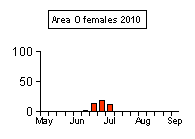 |
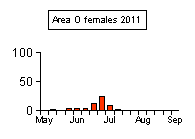 |
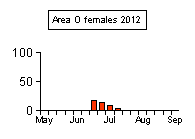 |
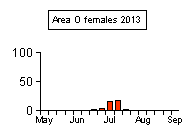 |
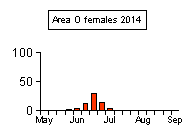 |
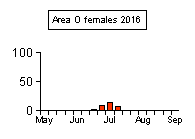 |
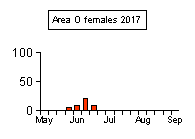 |
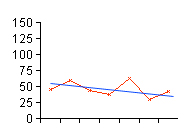 |
| Grid ref: Centred at SK606666 | |||
| Habitat: Section O consists of a stone surfaced forest track, north-facing for much of its length and formerly having a much more sheltered and enclosed aspect prior to the recent forestry operations. This section has always been more vegetated than the similar sections of K and J, with plants such as Hogweed, Bracken, Bramble and Nettle dominating. In late 2016, the track was greatly widened, effectively restoring the track to its original width and a new lorry turning point was built near Peafield Lane. There was a large amount of timber stacking in parts of this section during the latter months of 2016 and early months of 2017. | |||
| Average percentage of total site population (females) 2010 - 2017: ... 14.70% | |||
| Percentage of total site population (females) in 2017: ... 15.41% | |||
| Population trend: ... Steadily declining, but less so than in other sections. Counts in 2017 were almost identical to those found in 2010. | |||
| Section K | |||
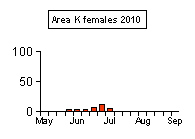 |
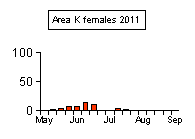 |
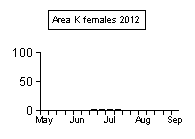 |
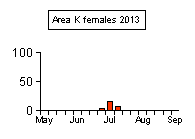 |
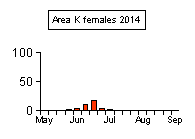 |
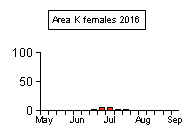 |
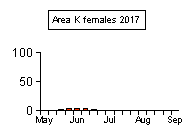 |
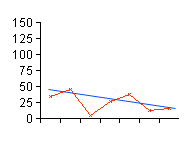 |
| Grid ref: Centred at SK606669 | |||
| Habitat: Section K has a southerly aspect and consists of a stone surfaced forest track, running south from a point almost mid-way between the highest (T2) and lowest (T1) points of the site. The whole section was formerly given protection by mature Pines (removed by forestry operations in 2016) which also provided shade during hot weather. Track sides are well vegetated with Grasses, Hogweed and Bracken and have become slightly banked up through years of spoil placement, as a result of track widening and scraping after the Dukeries Car Rally. | |||
| Average percentage of total site population (females) 2010 - 2017: ... 8.20% | |||
| Percentage of total site population (females) in 2017: ... 8.03% | |||
| Population trend: ... Declining. Produced similar counts in 2016 and 2017, which are well down on most years. | |||
| Section J | |||
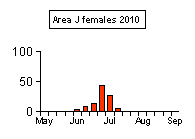 |
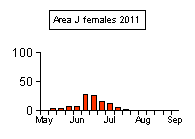 |
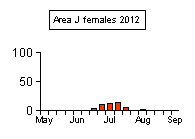 |
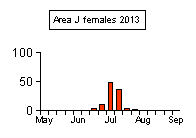 |
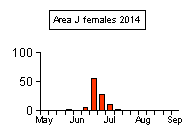 |
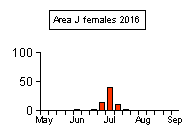 |
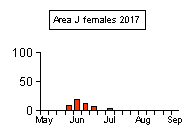 |
 |
| Grid ref: Centred at SK606672 | |||
| Habitat: Section J runs either side of another stone surfaced forest track, well vegetated with woodland plants such as Hogweed, Bracken and Nettle, running south from a high point at the Centre Tree (SK606675), before joining Section K mid-way between the highest and lowest points of the site. Similarly to Section K, the track sides have become slightly built up through years of spoil placement. Habitat along the whole of the western side of Section J, was also affected by forestry operations in 2017. | |||
| Average percentage of total site population (females) 2010 - 2017: ... 28.20% | |||
| Percentage of total site population (females) in 2017: ... 27.59% | |||
| Population trend: ... Declining. | |||
| Section D | |||
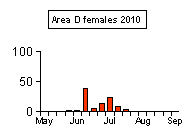 |
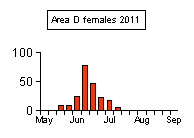 |
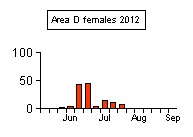 |
 |
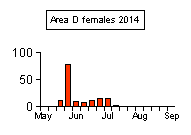 |
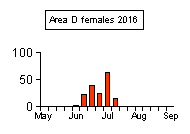 |
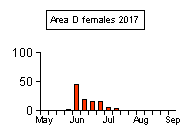 |
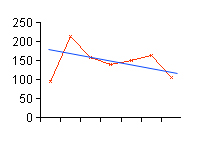 |
| Grid ref: Centred at SK606673 | |||
| Habitat: Section D is a south facing, grass section running downwards alongside the adjacent Section J and forms part of a long grass section including the former survey sections of A, B and C. The grass has always been cut by tractor mower in early Spring or late Autumn, and usually to a height of four inches, but been uncut since early 2016. This has allowed the spread of invasive plants such as Bramble, Willowherb and Bracken, but scrub is becoming a problem in parts of Section D, though currently less so than in the other three grass sections. | |||
| Average percentage of total site population (females) 2010 - 2017: ... 48.86% | |||
| Percentage of total site population (females) in 2017: ... 48.92% | |||
| Population trend: ... Declining, though still produces around 50% of the surveyed population. Numbers have declined down to those recorded in 2010 after the huge increase (more than double) in 2011. | |||
| ... | ||
| Are Glow Worms
increasing on site? It seems likely that Glow Worms can survive forestry operations in just enough numbers, so as to maintain a viable breeding population. After operations have ceased, there is the possibility that Glow Worm numbers have been affected so much, that populations gradually become more fragmented and isolated, especially with a succession of poor breeding seasons, or if there are naturally fewer males around in some years. In the past few years, we have found very small numbers of Glow Worms in neighbouring plantations. These have been near enough to Clipstone Old Quarter to presume that at one time, they would have been part of a larger population covering a much larger area of the forest than they do now. |
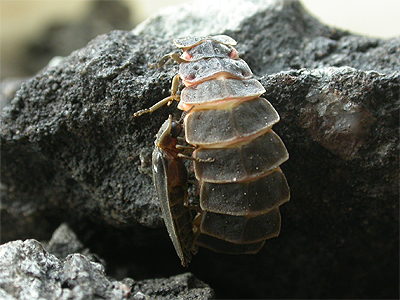 |
|
| ... | ||
| Finding Glow
Worms at nearby sites is an not indication that Glow
Worms are colonising new areas, but are merely small,
isolated and previously overlooked populations. Good
evidence of any range increase, would be if we were now
recording Glow Worms further west along Section M (see
map below) than we were in 2009 and 2010. This is not the
case, but we do occasionally check. Having a smaller survey area, does occasionally allow us the time to survey new areas near to Clipstone Old Quarter, or in the Sherwood Forest area in general. As mentioned, we occasionally find Glow Worms in previously unknown areas and in 2017, found two females in locations that effectively linked a small population along the edge of woodland to the Clipstone Old Quarter population. The locations of these (and other recent records) are shown in blue below. The arrowed red lines mark the limits of our former survey area, along which Glow Worms were recorded. |
| ... | ||
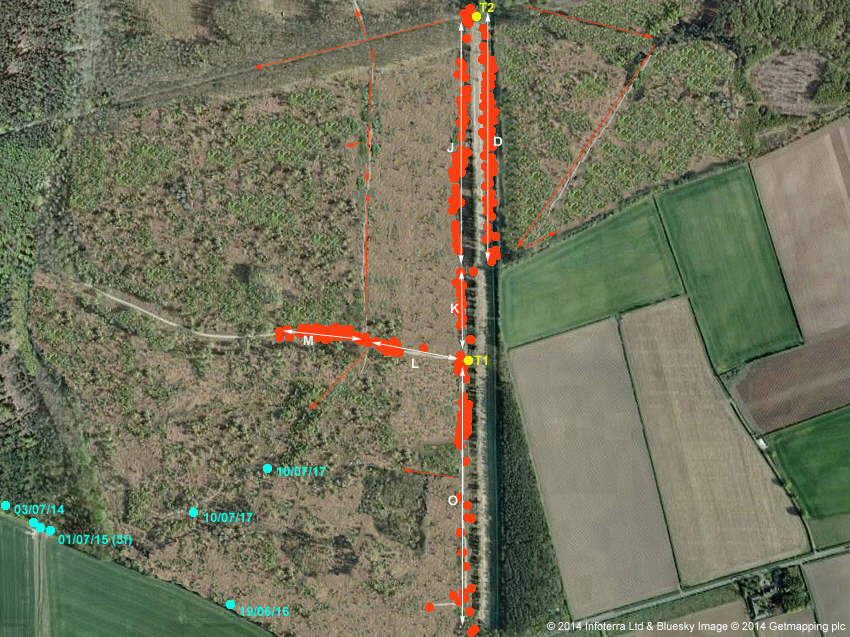 |
||
| ... | ||
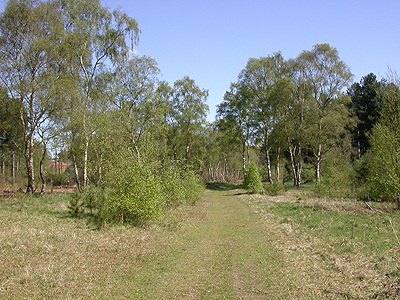 |
Unfortunately,
most sites failed to produce any Glow Worms, but the
deployment of artificial lures proved a useful method
allowing a number of sites to be surveyed simultaneously.
Lures were left in suitable habitat, while other areas or
sites were being walked. Martin and Ludwik had negative results from previously reported Glow Worm sites at Robin Hood Hills, Nomanshill Wood, Thieves Wood and Rob Lane, and potential sites at Annesley Woodhouse Quarry and nearby Bentinck Banks SSSI. Thankfully, they did record Glow Worms from new areas of Harlow Wood. We unsuccessfully surveyed an old Glow Worm site at Thoresby Park, but did find two females and a larva on heathland at Budby South Forest, which increased the range of a known population at nearby Swinecote Road, Budby and may actually be the correct location for historical records listed as Budby dating to 1929. |
|
| A very
suitable looking site at Crookford north of Bothamsall
(pictured above) also provided negative results, as did
several surveyed areas within Sherwood Forest Country
Park, confirming that Glow Worms are are indeed confined
to just one location within the Country Park itself. Below is the complete list of sites surveyed for Glow Worms during 2017. Those sites producing Glow Worms are highlighted in blue. Negative site visits are in grey. |
||
| Surveyed | Site name | Grid ref | Site type/habitat | Qty | Notes | Recorder | ||||||
| ........................ | . | ........................................................ | . | . | . | ................................................ | . | . | . | . | . | |
| July 8th | Plantation Lane, Hodsock | SK625853 | Mixed woodland, grass verge | 0 | No Glow Worms recorded | LM. | ||||||
| July 7th | Rob Lane, Loath Hill and Robin Hood Hill | SK634535 | Mixed woodland, grass verge and meadowland | 0 | No Glow Worms recorded | MD. LM. | ||||||
| July 7th | Gibraltar Plantation | SK605723 | Coniferous plantation | 0 | No Glow Worms recorded | TP. DP. | ||||||
| July 6th | Sherwood Heath | SK647675 | Heathland | 1 | Single female present and two males attracted to artificial lures. | MD. IM. | ||||||
| July 5th | Sherwood Forest CP | SK606685 | Deciduous woodland | 0 | No Glow Worms recorded. Surveyed area was just outside the Country Park boundary. | TP. DP. | ||||||
| July 5th | Budby South Forest | SK604691 | Heathland | 0 | No Glow Worms recorded | TP. DP. | ||||||
| July 5th | Budby South Forest | SK603693 | Heathland | 0 | No Glow Worms recorded | TP. DP. | ||||||
| July 5th | Clumber Park | SK635772 | Coniferous woodland and grass verge | 0 | No Glow Worms recorded on a walk between SK629772 and SK640772. Glow Worm's last recorded in this area of Clumber (Calloughton Wood) back in 2004. | LM. | ||||||
| July 3rd | Swinecote Road, Budby | SK627688 | Grass verge | 0 | A previously known site at the junction of the A616 and the B6034. No Glow Worms recorded. | TP. DP. | ||||||
| July 3rd | Sherwood Forest CP | SK622681 | Grass heathland | 0 | No Glow Worms recorded | TP. DP. | ||||||
| July 3rd | Sherwood Forest CP | SK625681 | Heathland | 0 | No Glow Worms recorded | TP. DP. | ||||||
| July 3rd | Sherwood Forest CP | SK611676 | Grassy, woodland ride | 0 | No Glow Worms recorded. A maximum of five females recorded from this location in 2013. | TP. DP. | ||||||
| July 3rd | Sherwood Forest CP | SK613684 | Oak/Birch woodland | 0 | No Glow Worms recorded. A known Glow Worm site, set within the Sherwood Forest CP. | TP. DP. | ||||||
| July 2nd | Clumber Park | SK613762 | Mixed woodland, grassland and heathland | 2 | Two females present. Glow Worms last recorded from this area of Clumber in 2012 | LM. | ||||||
| June 24th | Sherwood Forest CP | SK626682 | Oak/Birch woodland | 0 | No Glow Worms recorded | TP. DP. | ||||||
| June 22nd | Crookford | SK670651 | Grassland and scrub | 0 | No Glow Worms recorded | TP. DP. | ||||||
| June 20th | Sherwood Heath | SK647675 | Heathland | 0 | No Glow Worms recorded | LM. | ||||||
| June 20th | Amen Cormer | SK641654 | Grassland/meadow | 0 | No Glow Worms recorded, or males attracted to artificial lure | LM. | ||||||
| June 20th | King's Stand Plantation | SK640656 | Deciduous woodland | 0 | No Glow Worms recorded | LM. | ||||||
| June 20th | Thoresby Park | SK645719 | Grass verge | 0 | No Glow Worms recorded along a recently mown stretch of verge on Netherfield Lane, between SK645719 and SK638717 | TP. DP. | ||||||
| June 20th | Thoresby Park | SK630710 | Grass verge/parkland | 0 | Former Thoresby Market entrance. Glow Worms recorded here some years ago. None recorded on this visit, but some limited habitat present. | TP. DP. | ||||||
| June 19th | Thieves Wood | SK547568 | Largely coniferous woodland | 0 | No Glow Worms recorded, or males attracted to artificial lure | MD. LM. | ||||||
| June 19th | Rob Lane and Comb Wood | SK635546 | Largely deciduous woodland and grass verge | 0 | No Glow Worms recorded, or males attracted to artificial lure | MD. LM. | ||||||
| June 18th | Swinecote Road, Budby | SK627688 | Grass verge | 0 | No Glow Worms recorded | TP. DP. | ||||||
| June 18th | Budby South Forest | SK624690 | Heathland | 1 | Single female (different to female of 12/06/17) and one 10mm larva found. Part of a known Glow Worm population at nearby Swinecote Road, Budby. | TP. DP. | ||||||
| June 17th | Bradmer Hill | SK598665 | Woodland edge | 0 | No Glow Worms recorded. Very small numbers (max of three in 2015) known from this location | TP. DP. | ||||||
| June 17th | Near Peafield Lane | SK601664 | Woodland edge | 0 | No Glow Worms recorded. Single female found at this location in 2016 | TP. DP. | ||||||
| June 17th | Clipstone Old Quarter | SK601666 | Deciduous woodland | 2 | Two females present, centred at this grid ref. This location effectively links the above two locations with the large population at Clipstone Old Quarter. A single larva recorded here in 2016 | TP. DP. | ||||||
| June 16th | Thieves Wood | SK547562 | Largely coniferous woodland | 0 | No Glow Worms recorded | MD. LM. | ||||||
| June 16th | Nomanshill Wood | SK546561 | Largely coniferous woodland | 0 | No males attracted to artificial lures placed at two locations. See report below. | MD. LM. | ||||||
| June 16th | Harlow Wood | SK552564 | Deciduous woodland | 3 | Three females recorded, extending east from this grid ref. Two of these were found close to a known population, but a single female was present close to the A60, at the given grid ref | MD. LM. | ||||||
| June 15th | King's Clipstone | SK610647 | Roadside verge/bank | 0 | No Glow Worms recorded | TP. DP. | ||||||
| June 14th | Sherwood Heath | SK647675 | Heathland | 0 | No Glow Worms recorded. Site maxima of 207 and 212 females here on two dates in 2008. Very small numbers of females since. | TP. DP. | ||||||
| June 12th | Budby South Forest | SK621693 | Heathland | 0 | No Glow Worms recorded | TP. DP. | ||||||
| June 12th | Budby South Forest | SK624690 | Heathland | 1 | Single female found away (but part of same population) from a known Glow Worm site at nearby Swinecote Road, Budby. No Glow Worms previously reported from this site, which was surveyed once in 2012 | TP. DP. | ||||||
| June 9th | Annesley Woodhouse Quarry | SK489533 | Unimproved grassland and scrub | 0 | No female Glow Worms recorded, or males to lure | MD. LM. | ||||||
| June 9th | Bentinck Banks SSSI | SK493554 | Grassland | 0 | No Glow Worms recorded | MD. LM. | ||||||
| June 9th | Robin Hood Hills | SK512546 | Unmanaged woodland with Bracken growth | 0 | Large numbers of Glow Worms reported from this site in 1968 and habitat appears to have have changed or deteriorated substantially since. No female Glow Worms recorded, or males to lure. | MD. LM. | ||||||
| May 25th | Harlow Wood | SK555565 | Coniferous plantation | 2 | Known healthy colony | JK. | ||||||
| May 25th | Swinecote Road, Budby | SK627688 | Grass verge | 0 | A previously known site at the junction of the A616 and the B6034 | TP. DP. | ||||||
| May 20th | Clipstone Old Quarter | SK647675 | Former Pine plantation, deciduous woodland and grassland | 1 | Single female | TP. DP. | ||||||